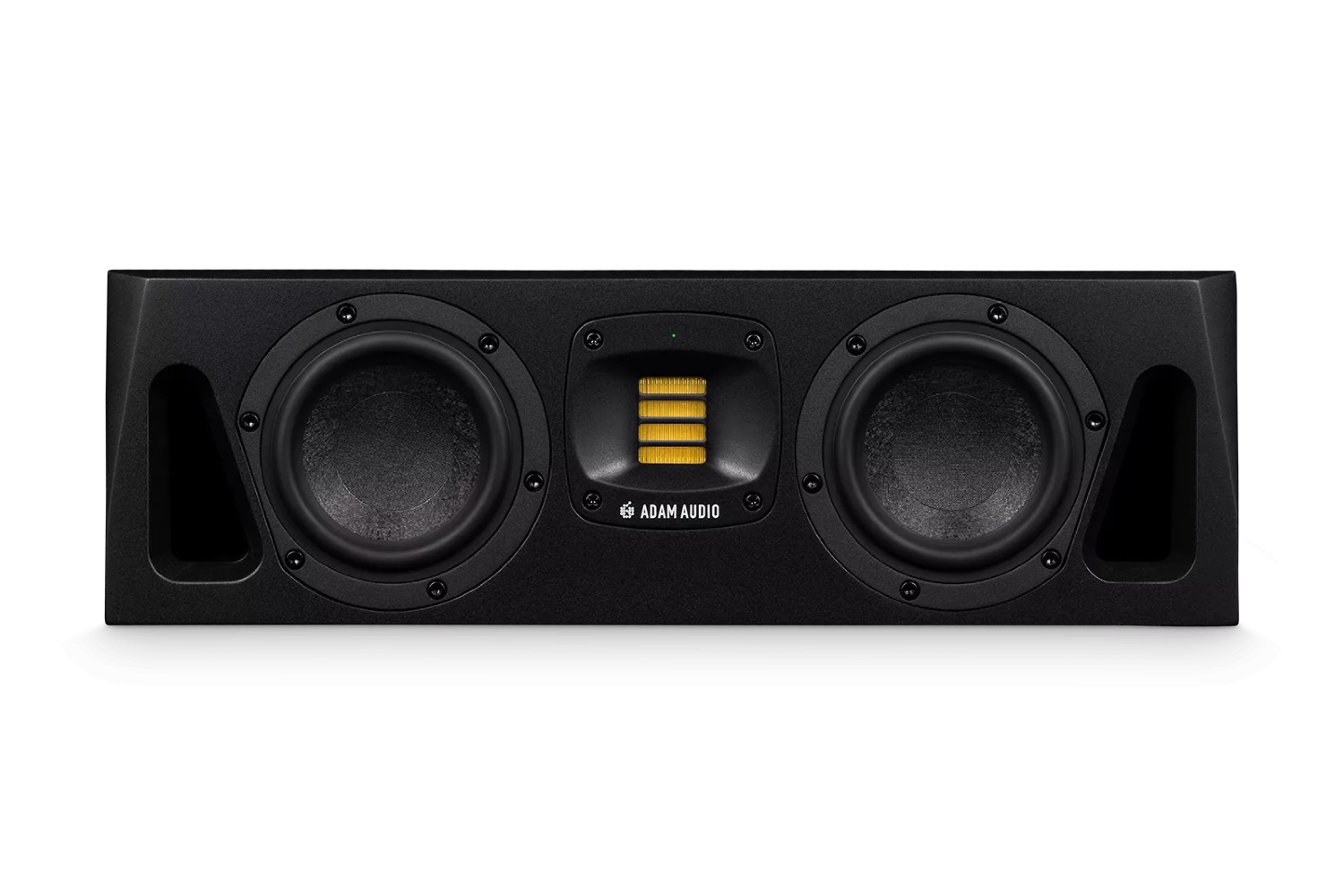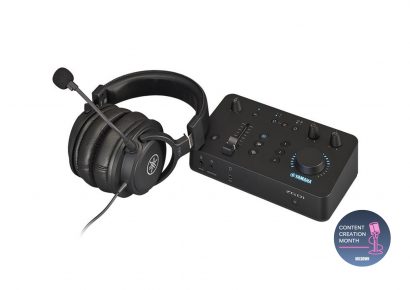Focusrite Australia | Enquire for pricing
Being able to boast technological innovation and redefining the term industry standard in the pro studio monitors world, all eyes (or more pertinently, ears) are transfixed when a company drops a new product line. Earlier this year ADAM Audio did just this with their new A-series line of studio monitors, replacing the famed AX family of monitors. But aside from just directly replacing their predecessors, the new A-series line also includes a couple of exciting additional models, one being the ADAM Audio A44H.
Check out more gear reviews here.
The new five-member family of monitors boasts a healthy dose of two and three-way designs, covering all bases from compact, vertical orientated near-fields through to beastly three-way powerhouses – providing solutions from the smallest of home studios, through commercial-sized spaces and immersive audio systems. The A44H sits nicely in the middle of all these options, being a rather flexible option, capable of handling multiple monitoring tasks.
Spec’d up
The ADAM Audio A44H is a two-way powered studio monitor, with a familiar 19” width and compact overall profile, being noticeably shallower in height compared to other horizontally orientated monitors available.
Two 4” Multi-Layer Mineral (MLM) woofers (comprised of six layers) take care of low end duties. Their Class-D PWM amplifier comes in with a peak (10% THD, limiter deactivated) of 110W and RMS (1% THD, limiter deactivated) 90W. All-round solid performance.
The A44H of course proudly encompass ADAM Audio’s prized X-ART tweeter, handmade in Berlin. The tweeter has a 2” equivalent diameter and is surrounded by a high frequency propagation waveguide, providing more accurate and even dispersion, this being 120-degree horizontal and 70-degree vertical. The tweeter module itself is rotatable 90 or 180 degrees. Yes, this means the ADAM Audio A44H isn’t limited to its default horizontal orientation and can be positioned vertically as well, which, depending on one’s space or application is a big plus, without running into the habitual acoustical issues reorientation can invite without a rotatable waveguide.
The tweeter amplifier is a Class A/B type, running at a peak (10% THD, limiter deactivated) of 20W and RMS (1% THD, limiter deactivated) 15W. The crossover frequency sits at 2.4kHz. The overall performance and frequency response of the A44H is solid, with a rated frequency response of 49Hz-41kHz at -3dB and 46Hz-45kHz at -6dB, with a max peak SPL at 1m per speaker of 110dB (IEC-weighted noise) and 103dB SPL (sine-bursts).
As for connectivity, inputs on the rear panel are either XLR (balanced) or RCA (unbalanced). Input level can be adjusted from 0dB positioned at noon on the dial located on the back panel, through to -12dB and +12dB. My only criticism here is that the dial isn’t stepped, which I’m always a fan of for these types of critical controls, for more precise matching, but this isn’t a deal breaker. As expected, the A44Hs come with a sound five-year warranty (when registered) for peace of mind.
Across the new A-series range, some rather convenient voicing options are included and are selectable via the rear panel button. These voicings are pure – a more linear response curve and UNR (Uniform Natural Response) – a more colourful voicing, which will be recognisable to those familiar with older ADAM Audio monitors, including the trusted AX series. Lastly, the Ext voicing harnesses the ADAM Audio A Control, which can be used in either the Advanced or Sonarworks SoundID Reference modes. All these voicing options provide a wealth of possibilities for users to tailor their monitors from subtle to more refined tuning via Sonarworks SoundID, which is some impressive integration and processing under the hood to say the least.
Room adaption toggles are included on the back panel also, ideal for fast and effective adjustments. Four bands named bass, desk, presence, and treble can be finely adjusted between -1dB and -4dB or +1.5dB dependent on the frequency band, giving plenty of fine tuning if required.
While these settings are certainly useful for those using their monitors in the one space, being able to slightly tweak to that environment, having these adjustable parameters available for those continually working in unfamiliar environments will likely be a welcomed feature. A comprehensive section in the user manual provides some useful settings for typical room placements, which provides a great starting point.
Sound profile
As I had been when reviewing the A7V model, I was eager to test the A44Hs out with some familiar reference material, as well as opening up a session and putting them to work on a mix.
Given the 19” width, the A44Hs didn’t feel cumbersome or overwhelming in size, but instead rather compact, comfortable, and easy to place. Their lower profile looks awesome, particularly with the dual 4” woofers and dual-sided flare porting on the front. These monitors look the business.
Upon firing them up, the now familiar boot up sequence did its thing, with the front LED indicator going from orange to green. Putting on some familiar material, I was immediately impressed with the punchiness of the A44Hs. Tight, defined, and not over working. Turning them up (not quite to 11), really allowed the woofers to work and the dual design really came into its own. Upon quieter testing, detail and clarity was nicely retained, with the upper-midrange and top end really being shown off through the X-ART tweeter. Silky smooth and not the least bit fatiguing.
Turning to a Pro Tools session, I immediately found mix decisions quick, easy, and consistent. Monitoring at different volumes again allowed for instantaneous feedback and direction, without much second guessing. Throwing on my familiar set of headphones as a reference check confirmed this, and I was able to build a cohesive mix quite fast given these weren’t my usual set of monitors. The clarity in the mid range I found particularly appealing, helping sculpt space for guitar and vocals and informing me where I needed to spend more or less time finessing. The detail in the top end was wonderful for determining reverb decay and delay times, as well as modulation. I didn’t find the A44Hs to be overwhelming in any parts of the frequency spectrum, not hyped, nor under baked – overall an honest representation of source material.
A lasting impression
Given their unique profile and quite striking appearance, the ADAM Audio A44H is no doubt going to turn some heads. They certainly did for me when having them setup for review. Their slender height will no doubt make them an appealing option for multi channel or immersive setups (it’s almost born to be placed as a centre channel), and it’s clear that the engineering wizards over at their Berlin HQ put some serious thought into this.
Not only an enjoyable monitor to listen to, but most importantly, an informative one. The ADAM Audio A44H monitors do indeed perform superbly in studio, providing the level of detail, clarity, and honesty one comes to expect from an ADAM Audio studio monitor. I’d happily spend countless hours on these monitors without even thinking about it. An excellent new monitor and an exciting new range.
Head to ADAM Audio for more. For local enquiries, reach out to Focusrite Australia.

